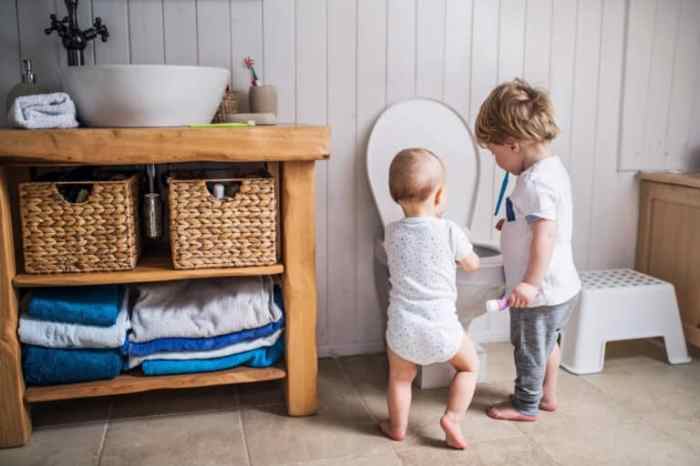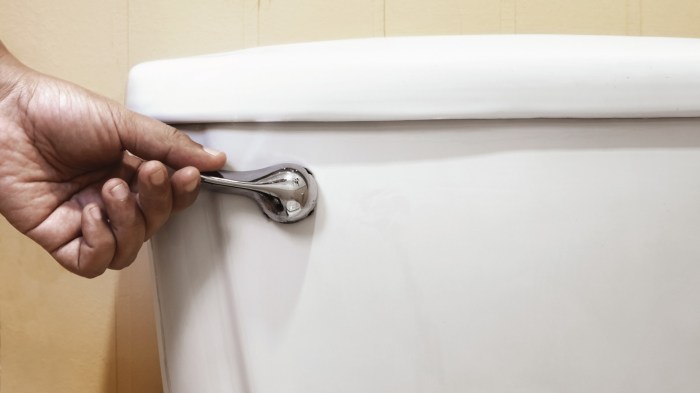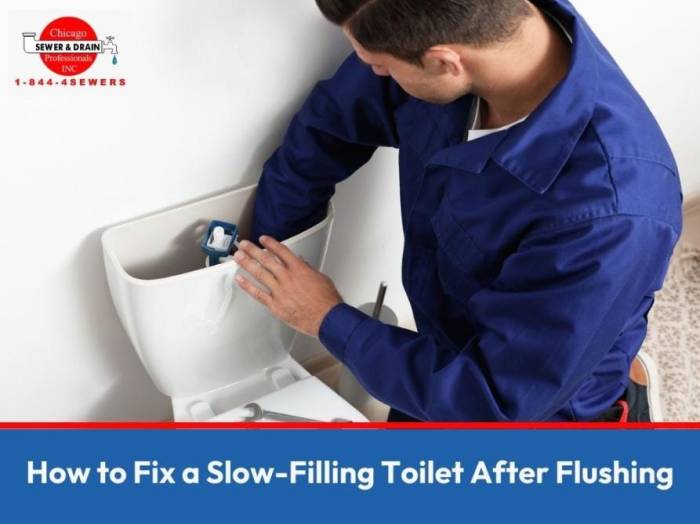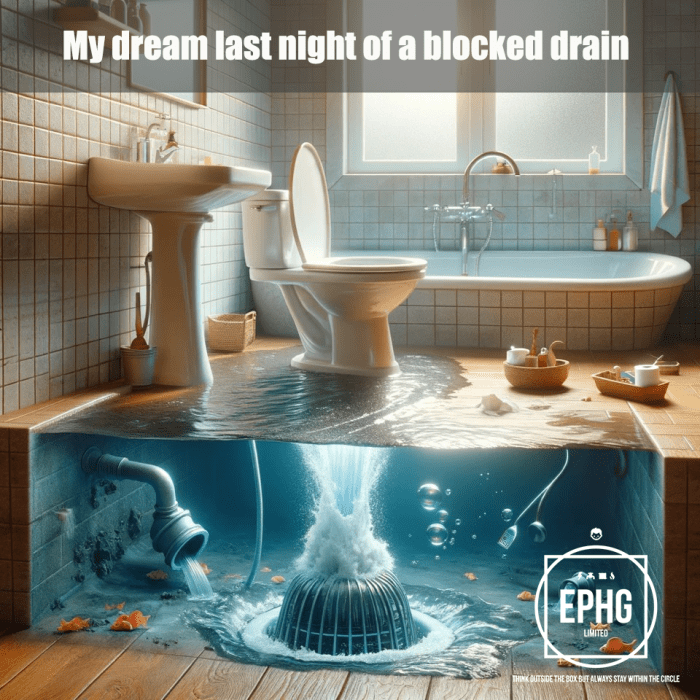Water Coming Up From Toilet and Shower A Guide
Water coming up from toilet and shower can be a frustrating plumbing problem. This guide will walk you through identifying the cause, diagnosing the issue, finding potential solutions, and preventing future problems. We’ll cover everything from overflow and backflow to clogged drains and faulty fixtures, equipping you with the knowledge to tackle this plumbing predicament.
Understanding the different ways water can back up from your toilet and shower, such as overflow, backflow, or leaks, is crucial for diagnosing the problem accurately. This guide will delve into the various components of your plumbing system, from drainpipes and traps to valves and fixtures, helping you pinpoint the root cause of the issue.
Identifying the Problem
Water backing up into toilets and showers is a common plumbing issue, often stemming from various causes within the plumbing system. Understanding the different types of backups and their potential origins is crucial for effective troubleshooting and repairs. This section details the various ways water can rise from drains, potential causes, and associated symptoms.
Plumbing systems are intricate networks, and blockages or malfunctions in any part can lead to water backups. Identifying the precise cause is often the first step towards a swift and effective resolution.
Causes of Water Backup
Plumbing backups can result from a range of issues within the system. Understanding these issues can facilitate diagnosis and resolution.
- Overflow:
- Overflow occurs when the water level in a fixture exceeds its capacity, typically due to a blockage in the drainpipe or an inability of the fixture to handle the water flow.
- Overflow can be a result of a clogged drain, a faulty drainpipe, or a fixture that is not designed to accommodate the volume of water being used.
- Examples include a sink overflowing due to a clogged drain, or a toilet overflowing from a full tank or blockage.
- Backflow:
- Backflow occurs when water flows backward through the pipes, often due to a faulty valve or a significant pressure difference in the system.
- This is frequently caused by a problem with the plumbing valves, a leak in a drain pipe, or a faulty water pressure system.
- Examples include a toilet overflowing because of a faulty drain valve, or a sink overflowing because of a faulty valve that is not working properly.
- Leaks:
- Leaks in the pipes, whether in the main line or in the connections to the fixture, can cause water to accumulate and eventually back up.
- These leaks are often caused by corrosion, age of the pipes, or damage from physical impact.
- Examples include a slow leak in a drain pipe that causes a gradual buildup of water, or a leak in a supply pipe that results in a constant overflow from a fixture.
Possible Causes by Plumbing Component
The plumbing system consists of interconnected parts. Problems in any of these parts can contribute to water backups.
- Drainpipes:
- Clogged drainpipes are a common cause of water backup, preventing water from flowing smoothly through the system. This can be caused by debris buildup or tree roots penetrating the pipes.
- Damaged or broken drainpipes can also allow water to accumulate and back up, requiring immediate repair.
- Traps:
- Clogged or malfunctioning traps can hinder the flow of water and cause backups, as traps are designed to prevent sewer gases from entering the house.
- Examples include traps that are blocked by foreign objects or traps that have developed a leak, hindering their function.
- Valves:
- Faulty valves, especially those controlling water flow, can cause backflow or allow water to accumulate in the pipes, leading to backups.
- Examples include valves that are stuck, leaking, or improperly installed, all of which can contribute to a water backup.
- Fixtures:
- Malfunctioning fixtures can contribute to overflow and backups, such as toilets with defective mechanisms or sinks with blocked drains.
- Examples include a toilet that is not properly flushing or a sink that is constantly overflowing due to a clogged drain.
Signs and Symptoms
Identifying the symptoms of a water backup is crucial for timely intervention.
- Water backing up in the toilet or shower:
- This is the most obvious sign. Water levels rise, and the fixture may overflow.
- Unpleasant odors:
- Sewer gases can rise with water backups, causing a foul smell.
- Slow draining fixtures:
- If water drains slowly or not at all, a blockage is a likely culprit.
Comparison of Water Backup Types
This table provides a comparative overview of the different types of water backups.
| Type of Backup | Cause | Symptoms | Typical Solutions |
|---|---|---|---|
| Overflow | Blocked drain, full tank | Water level rises, overflows | Unclog drain, repair tank |
| Backflow | Faulty valve, pressure difference | Water flows backward | Replace valve, repair plumbing |
| Leaks | Damaged pipes, corrosion | Water accumulation, slow drain | Repair or replace pipes |
Diagnosing the Issue: Water Coming Up From Toilet And Shower
Pinpointing the exact source of a persistent water issue in toilet and shower plumbing requires a systematic approach. This involves careful examination of the affected areas, followed by a methodical process of elimination. Understanding the potential points of failure within the plumbing system is key to effective troubleshooting.
Troubleshooting plumbing problems necessitates a methodical approach, proceeding from easily accessible points to more complex ones. A well-organized plan, incorporating visual inspections and simple tests, will help identify the source of the problem quickly and efficiently.
Toilet Drainpipe Troubleshooting
Thorough inspection of the toilet drainpipe system is crucial. Begin by checking the visible portion of the drainpipe for any obvious clogs or blockages. A visual inspection is important for identifying any debris, foreign objects, or unusual buildup that may be obstructing the flow. Furthermore, examine the area around the flange and the drainpipe for any signs of leakage or damage. Inspect the water trap for any signs of a leak or blockage.
Shower Drainpipe Troubleshooting
Similarly, examining the shower drainpipe system is vital. Inspect the shower drainpipe for any signs of clogs or blockages, paying particular attention to the area where the drainpipe connects to the main plumbing system. Examine the drainpipe for any signs of damage or leaks. Also, investigate the water trap beneath the shower drain for any obstructions.
Plumbing Fixture Inspection
Evaluating the plumbing fixtures themselves is another essential step. Inspect the showerhead and shower valve for any obstructions or signs of malfunction that might be preventing proper drainage. Similarly, examine the toilet tank and bowl for any visible leaks or problems with the flushing mechanism. Check for loose connections or damaged seals on the fixtures. The presence of unusual noises emanating from the fixtures could also indicate a problem.
Drain Trap Inspection
Testing the drain trap is critical to identifying the problem. Inspect the trap for blockages by removing the access cover. Look for debris, hair, or other obstructions. If you detect an obstruction, carefully remove the blockage. Check the trap for leaks by looking for water accumulating in the trap. If a leak is present, repair the necessary parts.
Plumbing Tool Identification
Knowing the correct tools can save time and effort during troubleshooting.
| Tool | Purpose |
|---|---|
| Pliers | Used for gripping and holding objects, tightening or loosening nuts and bolts. |
| Adjustable Wrench | Versatile tool for tightening or loosening nuts and bolts of various sizes. |
| Screwdriver | Used for turning screws. Different types of screwdrivers are used for different types of screws. |
| Pipe Wrench | Used for turning pipes. |
| Caulk Gun | Used for applying caulk to seal gaps and cracks. |
| Drain Snake | Used to remove clogs from drains. |
Potential Solutions
Addressing backed-up water in toilets and showers requires a systematic approach, considering the source of the blockage and the severity of the issue. A proactive strategy often prevents escalation and reduces costly repairs. This section details potential solutions, ranging from straightforward fixes to more intricate plumbing repairs.
A thorough understanding of the plumbing system, including the location of drainpipes, traps, and valves, is crucial for effective troubleshooting and repair. This knowledge allows for targeted interventions and prevents unnecessary damage.
Simple Fixes
A variety of simple fixes can often resolve minor clogs and leaks, avoiding the need for extensive repairs. These solutions often involve readily available tools and minimal effort.
- Using a Plunger: A plunger is a valuable tool for addressing clogs in toilets and sinks. The proper application of a plunger can dislodge obstructions, allowing water to flow freely. Ensuring the plunger creates a tight seal against the drain opening is critical for effectiveness. For example, a stubborn clog in a bathtub drain might be cleared with repeated plunges.
- Using a Drain Snake or Auger: A drain snake or auger is a flexible cable with a pointed end. This tool can be inserted into the drainpipe to physically remove obstructions, such as hair, soap scum, or small debris. Different sizes and designs of drain snakes cater to various drainpipe diameters.
- Checking for Clogs in Traps: A blockage in the plumbing trap, a U-shaped pipe below the fixture, can cause water to back up. A simple inspection and removal of any clogs or debris in the trap can restore normal drainage.
Replacing Parts
In cases where simple fixes are insufficient, replacing faulty components may be necessary. This approach requires some plumbing knowledge and appropriate tools.
- Replacing a Leaking Valve: A leaking valve can cause persistent water backups. Identifying and replacing the faulty valve, typically located under the sink or near the fixture, often resolves the problem. Replacing a leaky faucet valve can prevent ongoing water damage.
- Replacing a Damaged Drainpipe: A damaged or corroded drainpipe can hinder water flow. If a section of the pipe is damaged or shows signs of wear, it might need replacement. The replacement pipe should match the existing pipe’s diameter and material for a proper fit.
Structural Issues
More extensive structural issues may require specialized expertise and potentially costly repairs.
- Addressing Slope Issues: Plumbing systems rely on proper slope to ensure water drains correctly. If the slope is insufficient or altered, water can accumulate and back up. Checking the drain lines for correct slopes is crucial.
- Inspecting the Main Drain Line: If the problem persists, the main drain line may be the source. A blockage in the main drain line can affect all fixtures connected to it. This typically requires professional intervention.
Installing a New Drainpipe or Fixture, Water coming up from toilet and shower
Installing a new drainpipe or fixture requires careful planning and execution. Proper installation ensures optimal drainage and prevents future problems.
- Planning and Preparation: A detailed plan outlining the necessary steps, including the required materials and tools, is essential. The plan should also specify the exact location of the new drainpipe and its connection points.
- Installation Procedure: The new drainpipe must be securely connected to the existing system, with appropriate seals and supports. Connecting the new fixture to the drainpipe requires precise alignment and fitting. Using appropriate sealants and fittings ensures a watertight connection.
Preventing Future Problems
Maintaining a functional and problem-free plumbing system for your toilet and shower requires proactive measures beyond immediate troubleshooting. A preventative approach significantly reduces the likelihood of recurring issues, saving you time, money, and stress. This section details key strategies for preventing future plumbing problems.
Preventative Maintenance Guide
A proactive approach to maintenance is crucial for the longevity of your plumbing system. Regular inspections and maintenance not only prevent costly repairs but also enhance the efficiency and performance of your fixtures. Neglecting routine upkeep can lead to more significant and expensive problems down the road.
Regular Inspections and Maintenance
Regular inspections are vital for early detection of potential issues. Visual inspections should be conducted monthly to identify any signs of leaks, clogs, or unusual water pressure. Addressing these issues promptly can prevent minor problems from escalating into major repairs. Furthermore, annual professional inspections are recommended for a thorough assessment of the entire system.
Preventing Clogs and Blockages
Proper disposal practices are essential for maintaining clear drainpipes. Avoid flushing items not designed for the toilet, such as paper towels, feminine hygiene products, or excessive amounts of sanitary waste. Similarly, avoid pouring grease, oil, or other fats down the drain. These substances solidify and can lead to clogs in the pipes. Using a drain snake or a plunger can help remove minor blockages.
Reducing Water Backing-Up
Preventing water from backing up in your toilet and shower requires careful consideration of your disposal habits. Ensure that your toilet and shower drains are properly sized and installed to handle the expected flow of water. Regularly inspecting and maintaining these drains is important. A clogged drainpipe upstream of your toilet or shower can cause a backup. Promptly address any clogs or blockages that occur in drains that may affect other areas of your plumbing system.
Routine Plumbing Maintenance Checklist
- Monthly Visual Inspection: Check for leaks, unusual water pressure, or any signs of clogs around the toilet and shower fixtures. Note any changes and address promptly.
- Quarterly Drain Cleaning: Use a drain snake or plunger to clear any minor blockages in the shower and toilet drains. This helps maintain the proper flow of water.
- Annual Professional Inspection: Schedule a professional inspection of your plumbing system annually to identify and address potential issues before they escalate.
- Proper Disposal Practices: Educate household members about proper disposal practices for waste materials. Do not flush items not intended for the toilet. Avoid pouring grease or oil down the drains.
- Water Pressure Monitoring: Observe water pressure regularly to identify any sudden drops or increases. This may indicate a problem in the plumbing system.
Visual Aids

Source: homedude.co
Visual representations can significantly aid in understanding complex plumbing issues. These aids allow for a clearer comprehension of the system’s components and how problems arise. They are especially helpful in identifying potential causes and illustrating solutions, fostering a more efficient and effective approach to problem-solving.
Plumbing System Diagram
A typical plumbing system comprises interconnected pipes, fixtures, and valves. The illustration below highlights the toilet and shower drain lines, crucial for pinpointing the source of water backups. The diagram emphasizes the paths water takes through the system, from the fixtures to the main drain line.

Clogged Drainpipe Illustration
A clogged drainpipe often resembles a partially or completely obstructed pipe. The illustration below demonstrates a drainpipe with accumulated debris like hair, soap scum, and food particles, creating a blockage.

Faulty Drain Trap Demonstration
A faulty drain trap, which sits below the drain opening, can prevent proper water flow. In the illustration, the trap’s seal is compromised, allowing sewer gases to rise and water to back up into the fixture.

Plunger Use Illustration
A plunger is a common tool for unclogging drainpipes. The illustration below demonstrates the correct use of a plunger. The plunger creates a seal around the drain opening, allowing for the removal of blockages using a pumping motion.

Valve Structure and Water Backup
A typical valve, such as a shut-off valve, controls water flow in the plumbing system. A faulty valve or improper valve positioning can result in water backing up. The illustration below highlights the valve’s components and how improper closure or leakage can cause water to overflow from the fixtures.

Ultimate Conclusion

Source: cdn-website.com
In summary, dealing with water backing up from your toilet and shower requires a systematic approach. By understanding the potential causes, troubleshooting effectively, and implementing appropriate solutions, you can resolve the issue quickly and efficiently. This guide provides a comprehensive overview, from identifying the problem to preventing future occurrences, enabling you to confidently manage your plumbing system and maintain a functional home.
Remember, proactive maintenance and regular inspections are key to preventing future backups. By following the preventative measures Artikeld, you can ensure a smooth-running plumbing system and avoid costly repairs down the road.





